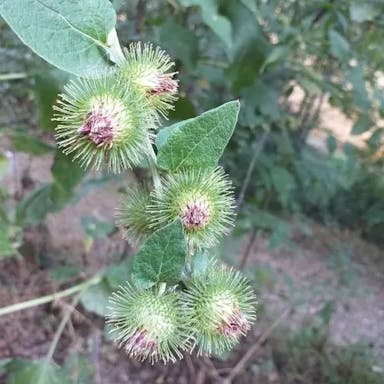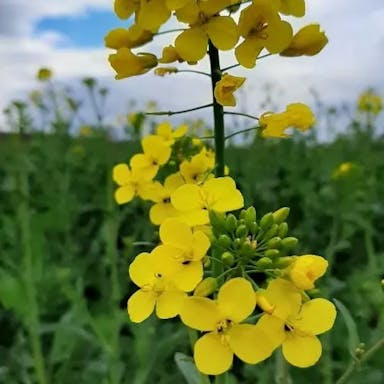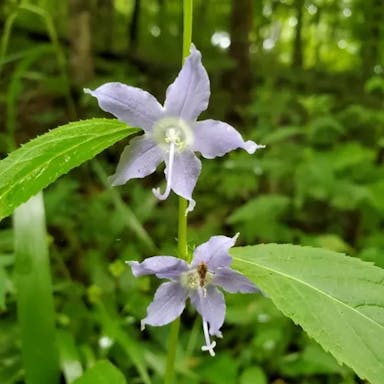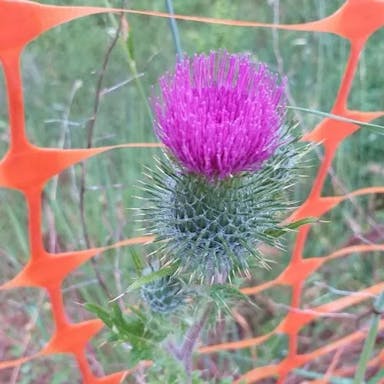Field thistle, scientifically known as Cirsium discolor, is a perennial plant native to North America. It belongs to the Asteraceae family and is characterized by its spiny leaves and pink to purple flowers. The plant can grow up to 3-6 feet in height and produces achenes as fruits. Cirsium discolor thrives in full sun to partial shade and well-drained soil. It is commonly found in prairies, meadows, and open woodlands. The flowers of Cirsium discolor attract pollinators like bees and butterflies, contributing to the ecosystem's biodiversity. This plant is relatively easy to grow in a garden setting, but its spiny nature requires careful handling. Cirsium discolor is often used in landscaping for its ornamental value and ability to attract beneficial insects. There are different varieties of Cirsium discolor, each with unique characteristics and adaptations to specific environments.
Field thistle
- Scientific name
- Cirsium discolor
Basic Information
- Asteraceae Family Cirsium Genus Field thistle Species
- Asteraceae > Cirsium > Cirsium discolor
- 83%
- The Completeness of This Encyclopedia
Please help us complete the encyclopedia, Terrarium is a encyclopedia service to be completed with everyone in the world. Currently, this page is 83% complete. For more information on how to contribute, please click here.
- Biennial
- Forb/herb
- Height
- 100cm ~ 200cm
- Flower Color
- Leaf Color
- Anthesis
- summer, fall
- Sunlight Exposure
Full Sun Long hours of sunlight from morning to afternoon Partial Shade A location in the shade of a tree or where either the morning or afternoon is shaded Full Shade A place where there is no direct sunlight
- Full Sun
- Hardiness Zones
This is an indicator to know to which zone each plant can winter. Knowing the zone of each plant gives you an idea of the cold temperature resistance when grown in the ground without a roof. 2: -42.7 to -40.0 3: -39.9 to -34.4 4: -34.3 to -28.9 5: -28.8 to -23.3 6: -23.2 to -17.8 7: -17.7 to -12.2 8: -12.1 to -6.7 9: -6.6 to -1.1 10: -1.0 to 4.4 11: 4.5 to 10.0
- 3-8
- Cold resistance
- Excellent
- Heat resistance
- Fair
- Habitat of origin
- United States
- Growth Rate
- Normal
What is Field thistle (Cirsium discolor)?
What is Field thistle (Cirsium discolor)
Flower meaning
The flower language commonly used in America for the plant called Field thistle is: - Independence - Resilience - Nobility One typical example is: - Independence: Field thistle symbolizes independence due to its ability to thrive in various conditions without much care or attention. It represents self-sufficiency and strength in the face of adversity. Birth flowers are specified by month and date only.
Calendar of Field thistle (Cirsium discolor)
Calendar
Field thistle in the United States typically blooms from mid-summer to early fall. The flowers are at their peak in August and September. Blooming occurs once a year, lasting for about 4-6 weeks. To extend the blooming period, deadhead spent flowers regularly. This practice encourages the plant to produce more blooms and prolongs the flowering season.
How to grow Field thistle (Cirsium discolor)
Watering
Field thistle should be watered deeply once a week during the growing season, ensuring the soil is moist but not waterlogged. In hot, dry weather, increase watering frequency to twice a week to prevent dehydration. During the dormant season, reduce watering to once every two weeks to mimic natural conditions. Monitor soil humidity by inserting a finger into the soil up to the second knuckle; if it feels dry, it's time to water. Avoid overhead watering to prevent fungal diseases. Adjust watering based on local climate conditions and soil type to maintain optimal growth and health of the Field thistle plant.
Soil and Fertilizer
Field thistle thrives in well-drained soils with a pH level between 6.0 and 7.5. It prefers sandy loam or loamy soils rich in organic matter. Fertilize the plant in early spring with a balanced fertilizer, such as a 10-10-10 mix, to promote healthy growth. Apply the fertilizer at a rate of 1 pound per 100 square feet of soil. Repeat the application in late spring or early summer if necessary. Avoid over-fertilizing as it can lead to excessive vegetative growth. Monitor the plant's growth and adjust the fertilizer application accordingly. Regularly check the soil quality to ensure it remains suitable for Field thistle.
Sunlight and Place
Field thistle thrives in full sun to partial shade, preferring at least 6 hours of direct sunlight daily. It exhibits moderate cold tolerance, surviving in USDA hardiness zones 3-9. The plant can withstand high temperatures but may benefit from some afternoon shade in extremely hot climates. During winter, it is advisable to provide protection from harsh winds and frost. Field thistle's optimal temperature range is between 60-80°F. It is essential to ensure well-draining soil to prevent waterlogging, especially during winter. This plant's strength lies in its ability to adapt to various light conditions, but it flourishes best in bright sunlight.
Advanced Information of Field thistle (Cirsium discolor)
Pruning
Field thistle benefits from regular pruning to maintain its shape and promote healthy growth. Pruning is necessary to remove dead or damaged stems, encourage new growth, and prevent overcrowding. The best time to prune Field thistle is in late winter or early spring before new growth appears. When pruning, use sharp, clean tools to make clean cuts just above a leaf node or lateral branch. After pruning, dispose of the cuttings properly to prevent the spread of diseases. Regularly cutting back Field thistle will help control its size and prevent it from becoming invasive in the garden.
Planting and Harvest
Field thistle is best potted in well-draining soil to prevent waterlogging. Ensure the pot has drainage holes to avoid root rot. When planting, place the thistle in a sunny location and water sparingly to mimic its natural habitat. Repot every 2-3 years to refresh the soil and provide more space for growth. Mist the plant occasionally to increase humidity, especially in dry indoor environments. Regularly check for pests and remove them promptly to maintain plant health.
Propagation
Field thistle can be propagated through seeds, division, or cuttings. Seeds are sown in well-draining soil in early spring or fall, lightly covered, and kept moist. Division involves separating the plant's roots into sections, each with shoots, and replanting them. Cuttings are taken from healthy stems, dipped in rooting hormone, and planted in a mix of soil and sand. Leaf cuttings can also be used by taking a healthy leaf, placing it in soil, and keeping it moist until roots develop. To ensure successful propagation, it is recommended to use a combination of methods to increase the chances of success and to harvest seeds or divisions at the appropriate time.
Pests and Diseases
Field thistle is susceptible to various pests and diseases, including aphids, thistle caterpillars, and rust fungi. These pests can cause damage to the plant by feeding on its leaves, stems, and roots, leading to stunted growth and wilting. Aphids can be controlled by introducing natural predators like ladybugs or by using insecticidal soap. Thistle caterpillars can be manually removed or treated with Bacillus thuringiensis. Rust fungi can be prevented by ensuring good air circulation around the plant and avoiding overhead watering. The withering of Field thistle can be attributed to the pests and diseases mentioned, which weaken the plant's ability to absorb nutrients and water. Regular monitoring and prompt action against these threats can help maintain the health of Field thistle plants.
Habitat of Field thistle (Cirsium discolor)
Habitat
Toxicity of Field thistle (Cirsium discolor)
Health Benefits
- edible
- Inedible
- Toxic
- No toxicity
NO DATA
Toxic for dogs and cats
NO DATA











